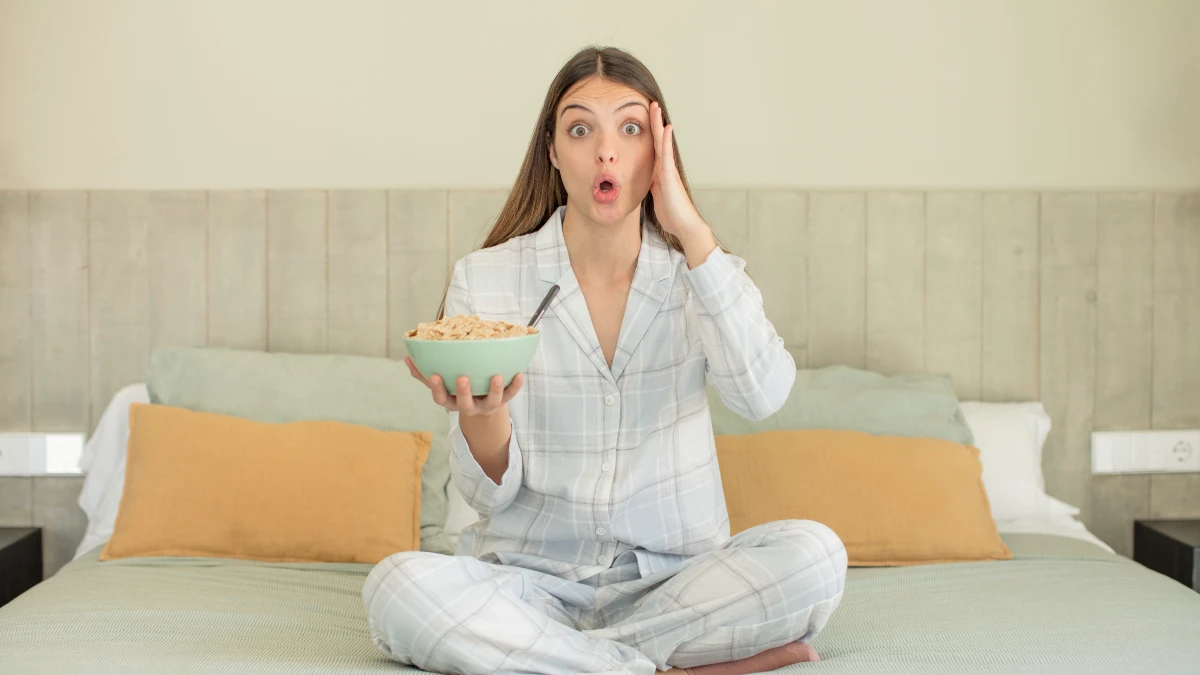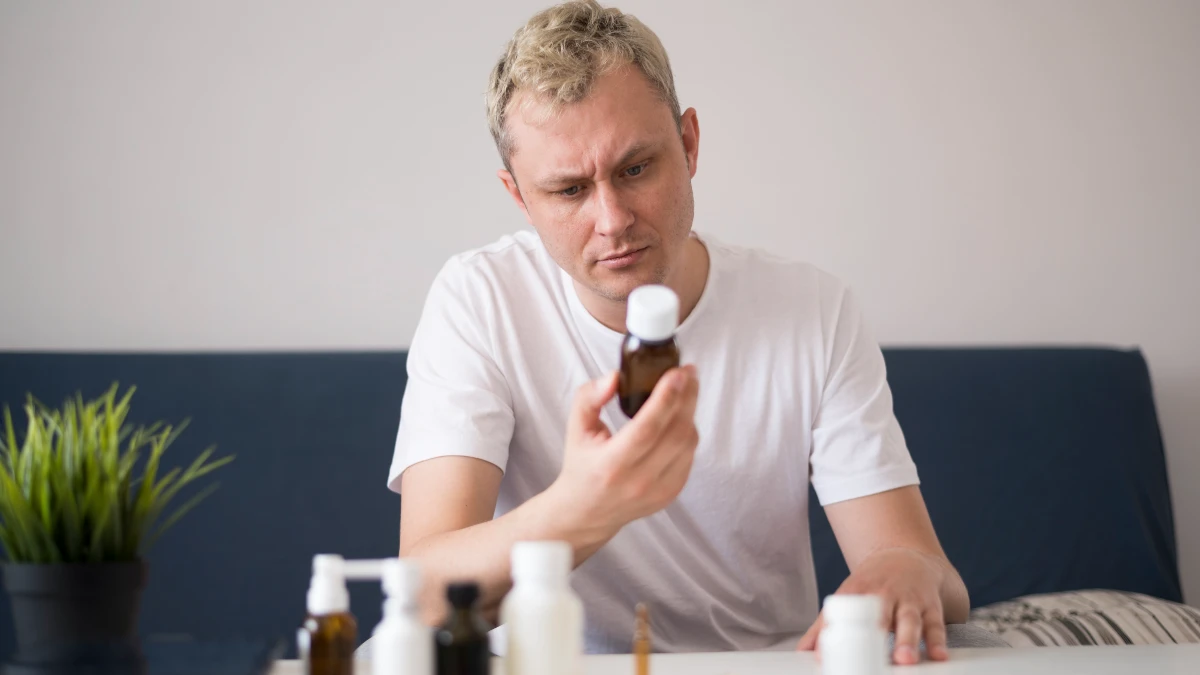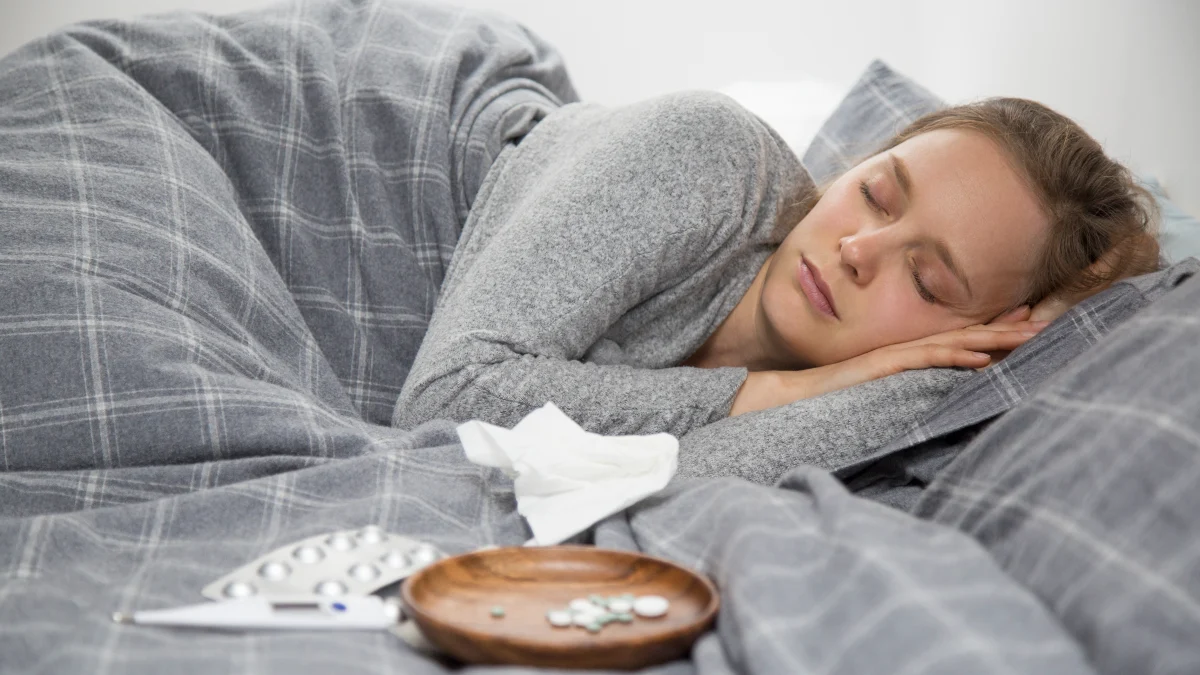That stubborn body fat won’t budge. Your workouts take days, not hours, to recover from. It’s frustrating and you might think it’s just “getting older.” But it is often a specific hormonal signal you can change.
This signal is Human Growth Hormone (HGH), your “youth hormone.” HGH is critical for metabolism, telling your body to burn fat and repair tissue. As we age, this hormone naturally declines.
Lose Body Fat (Especially Visceral Fat)
The Visceral Fat & HGH Connection
*Risk for normal-weight individuals with abdominal obesity (JAMA, 2025)
The Science: Research shows a direct link. For every 10cm² increase in visceral fat, peak Growth Hormone secretion can decrease by approximately 1µg/L.
Break the Cycle
Quick Check: A waist measurement over 40 inches (men) or 35 inches (women) often signals high levels of visceral fat.
Your body fat level is directly linked to your HGH production. The more body fat you have, especially deep belly fat (visceral fat), the less HGH your body produces.
This isn’t a small problem; it’s a metabolic trap. High levels of visceral fat actively impair your HGH secretion all day long. This low HGH then makes it harder for your body to burn fat. So, the fat you have is actively preventing you from losing it. This is the “Vicious Cycle”: Belly fat leads to low HGH, and low HGH leads to more belly fat.
The mechanism works both ways. Studies show that when people lose body fat, their 24-hour HGH release profiles are restored. Fat loss isn’t just a goal; it’s the first step to fixing your hormonal machinery. As you lose fat, your HGH production comes back online, which then helps you burn even more visceral fat.
1. Lose Body Fat (Especially Visceral Fat)

Your body fat level is directly linked to your HGH production. The more body fat you have, especially deep belly fat (visceral fat), the less HGH your body produces.
This isn’t a small problem; it’s a metabolic trap. High levels of visceral fat actively impair your HGH secretion all day long. This low HGH then makes it harder for your body to burn fat.
So, the fat you have is actively preventing you from losing it. This is the “Vicious Cycle”: Belly fat leads to low HGH, and low HGH leads to more belly fat.
The mechanism works both ways. Studies show that when people lose body fat, their 24-hour HGH release profiles are restored. Fat loss isn’t just a goal; it’s the first step to fixing your hormonal machinery.
As you lose fat, your HGH production comes back online, which then helps you burn even more visceral fat.
2. Master Intermittent Fasting (IF)

Intermittent fasting (IF) is an eating schedule, not a diet. The most popular method is the 16:8 schedule. This means you fast for 16 hours each day and eat all your meals in a single 8-hour window.
Fasting is one of the most powerful natural ways to boost HGH secretion. The numbers are stunning. Studies show that fasting for just 2 or 3 days can increase HGH levels by 2 or 3 times. One 24-hour fast was found to increase HGH levels five-fold. After 7 days, HGH secretion can increase by an incredible 1250%.
New research also confirms this boost happens independent of weight loss. This means the increase comes from the metabolic shift of fasting itself.
How does it work? Fasting dramatically lowers your insulin levels. When insulin is low, your body has to switch its fuel source. It stops burning sugar and starts burning its own stored fat. HGH is the hormone that helps make this switch.
Many people worry they will lose muscle if they fast. But the data shows the HGH spike during a fast is your body’s natural defense against muscle loss. The hormone tells your body to burn fat while preserving your muscle. It’s a fat-targeting, protein-sparing state.
You can start 16:8 today. For example, finish dinner by 8 PM, skip breakfast, and have your first meal at 12 PM. You can use an app like Zero to help track your fasting windows.
3. Use High-Intensity Interval Training (HIIT)

A HIIT workout is not a long, slow jog. It involves short bursts of maximum, all-out effort followed by brief rest. Think 30 seconds of sprinting, not 30 minutes of jogging. This is anaerobic training.
Intensity is the key. The powerful exercise-induced growth hormone response (EIGR) is only triggered when you push your body above its lactate threshold.
This “all-out” intensity engages your fast-twitch muscle fibers. This, plus the buildup of lactate, signals your brain to release a massive wave of HGH after the workout to repair the “damage.”
It’s important to know that HGH responds to stress and intensity, not just duration. Long, slow cardio is great for heart health, but your body adapts. That HGH response can become blunted. Jogging supports your heart, but sprinting signals the “youth hormone” for fat loss and repair.
Here is a sample 15-minute, no-equipment HIIT workout:
- 3-minute warmup (light jogging in place, jumping jacks).
- Perform 5 rounds of: 30 seconds of Squat Jumps (as fast as you can) followed by 30 seconds of rest.
- Perform 5 rounds of: 30 seconds of Burpees (as fast as you can) followed by 30 seconds of rest.
- 2-minute cooldown (walking, stretching).
4. Prioritize Deep (Slow-Wave) Sleep

This is the most important factor. You cannot out-train or out-fast poor sleep.
The single largest pulse of natural HGH release happens at night. It is perfectly synchronized with your first cycle of deep sleep (also called NREM sleep).
New 2025 research from UC Berkeley has confirmed this. Scientists found the brain circuits that actively produce HGH during non-REM sleep. They identified this process as “critical” for adult metabolism, building muscle, and burning fat.
You must reframe sleep. It is not a passive activity. It is your primary “repair and fat-burning” window.
A 6-hour night of sleep doesn’t just mean you’re “2 hours short.” It could mean you missed the entire HGH pulse. One bad night can undo the benefits of your fast and your HIIT workout. Your workout breaks down the muscle; your deep sleep rebuilds it stronger with HGH.
“Sleep hygiene” is HGH hygiene. Aim for 7-8 hours of quality sleep. Maintain a regular circadian rhythm (go to bed and wake up at the same time). You can track your sleep quality, especially your “deep sleep” stages, using apps like Sleep Cycle or wearables like an Oura Ring.
5. Slash Sugar & Refined Carb Intake

HGH and insulin are enemies. They work against each other.
When you reduce sugar and eat refined carbs (like white bread, pasta, or soda), your blood sugar spikes. Your body releases a flood of insulin to handle that sugar.
High circulating insulin levels block the secretion of HGH.
This hormonal imbalance (high insulin, low HGH) promotes more fat buildup. As we learned in Way 1, more fat then further reduces HGH. It’s the same vicious cycle.
The timing of your sugar is just as important as the amount. HGH has two main release windows: post-exercise (Way 3) and during deep sleep (Way 4). A high-sugar “recovery shake” right after your workout or a high-carb dessert before bed are the two worst things you can do.
You are spiking insulin at the exact moment HGH is supposed to rise, blunting the entire natural pulse.
6. Stop Eating 2-3 Hours Before Bed

This simple habit directly combines the principles of sleep (Way 4) and insulin (Way 5). When you eat before bed, especially a meal with carbs, you create an insulin spike.
That insulin spike (which takes 2-3 hours to come down) collides with your body’s biggest HGH pulse of the night. The high insulin blunts this critical release. You are stopping your HGH production before it even starts.
This is a powerful “lifestyle hack” that gives you a double benefit. First, it protects your critical sleep quality and HGH pulse. Second, it naturally extends your overnight fasting window (Way 2).
Set a “kitchen-closed” alarm for 3 hours before your bedtime. This lets your insulin levels fall, effectively “clearing the runway” for a maximum HGH release while you sleep.
7. Use Deliberate Heat Exposure (Sauna)

Sauna use is a form of “hormesis.” This is a mild, tolerable stress that forces your body to adapt in positive ways.
This acute heat exposure has been shown in studies to trigger a powerful HGH release. One study showed a two-fold increase. Another showed a five-fold increase. And a very intense protocol showed a massive 16-fold boost.
To get this HGH-specific benefit, you must follow a specific protocol, popularized by Dr. Andrew Huberman. It is infrequent but intense.
- Frequency: Only once per week or less.
- Protocol: Multiple sessions of 30 minutes each (at 176-212°F), with 5-10 minute cooling breaks in between.
- Timing: Do this in a semi-fasted state (at least 2-3 hours after a meal) to further boost the HGH release.
This part is critical. Using a sauna more frequently (like 2-7 times a week) is great for heart health, but your body will adapt. This adaptation blunts the massive HGH spike. To use heat for HGH, you must use it infrequently to preserve the “shock” value.
8. Optimize Your Vitamin D Levels

Vitamin D isn’t just a vitamin; it functions like a hormone. It is critical for the entire HGH and IGF-1 axis to work properly.
Think of Vitamin D as a “permissive” nutrient. Your HGH signaling won’t work without it. Studies on children with HGH deficiency found that those also deficient in Vitamin D had a slower growth response, even when they were given HGH treatment.
More is not always better. A 2023 study of over 6,000 people found a non-linear relationship. HGH levels (measured by IGF-1) increased with Vitamin D levels up to a certain point (75 nmol/L). After that, the correlation surprisingly became negative.
The goal is not megadosing; it’s correcting deficiency.
- Get sensible, non-burning sun exposure.
- Ask your doctor for a
25(OH)Dblood test. - If you are deficient, supplement. The RDA is 600-800 IU, but many experts suggest 1500-2000 IU daily to maintain healthy levels.
9. Correct Magnesium Deficiency

Like Vitamin D, magnesium is another “permissive” nutrient for the HGH-IGF-1 axis.
HGH does its work through its downstream partner, IGF-1. A magnesium deficiency can cause post-receptor defects, meaning the HGH signal is sent but not received.
Research shows that restoring magnesium levels restores IGF-1 levels.
This section, with Way 8, reinforces a key idea: boosting GH secretion (from fasting and HIIT) is useless if the downstream signaling is broken by a simple nutrient deficiency.
Focus on magnesium-rich foods like spinach, almonds, and dark chocolate. A magnesium glycinate supplement before bed is also a great option, as it helps support deep sleep (Way 4).
10. Strategize Amino Acid Intake (Glutamine, Ornithine, Arginine)

Certain amino acids, in large doses, can stimulate the pituitary gland to release HGH.
Glutamine
A small study found a 2g dose of glutamine could temporarily boost HGH by 78%. You can also get it from foods like eggs, fish, and spinach.
Ornithine
This amino acid can be taken 30 minutes after a workout to support HGH production.
L-Arginine (The Critical Nuance)
This is the most important part of this section.
At Rest
Yes, a 5-9g dose of L-arginine on an empty stomach can stimulate HGH release.
THE CONTRADICTION
Taking L-arginine before exercise is a huge mistake. Studies show it blunts and reduces the (much larger) HGH response you get from the exercise itself.
Many people take an amino acid supplement with Arginine as a pre-workout for “pump.” This reveals that this popular habit is actively working against your HGH goals.
STOP-DOING-THIS. Do not use L-arginine as a pre-workout. To use it for HGH, take 5-9g on a rest day or before bed, but never before a workout.
11. Consider GABA Supplementation

A GABA supplement (gamma-aminobutyric acid) provides the body’s main “calming” neurotransmitter.
GABA supports HGH in two ways. First, it can improve sleep quality, which supports the main sleep pulse (Way 4).
Second, it has a direct effect. Unlike Arginine, GABA augments (increases) the HGH response from exercise.
Let’s contrast this with Way 10.
- Arginine + Exercise = Bad
- GABA + Exercise = Good
One study found a 3g dose of GABA at rest boosted growth hormone concentrations by 400%. Even better, when 3g of GABA was taken with exercise, it led to 200% greater HGH levels compared to exercise alone.
The GABA dosage for HGH is much larger than for sleep. You need a pharmacological dose of 3-5 grams (3,000-5,000 mg).
A 3g dose of GABA, taken either at rest or post-exercise, is effective. A great strategy is to take it post-exercise in the evening to support both repair and sleep.
12. Use Melatonin (For More Than Just Sleep)

Melatonin is the “sleep hormone.” By helping you fall asleep and improving sleep quality, it supports the main sleep-HGH pulse (Way 4).
But melatonin also appears to have a direct effect on growth hormone secretion, separate from sleep.
It’s thought to work by lowering somatostatin. Somatostatin is the body’s “brake” on HGH. Melatonin may help “release the brake,” allowing more HGH to be produced.
A 2025 case study shows how potent this is. A 34-year-old woman taking 2mg of melatonin for sleep disturbances showed elevated GH and IGF-1 levels. Doctors were concerned. But when she stopped taking melatonin, her HGH levels went completely back to normal, showing the melatonin was the direct cause.
This is not a “more-is-better” supplement. Start with a low dose (0.5-3mg) 30-60 minutes before bed.
This is for informational purposes only. For medical advice or a diagnosis, consult a professional.
Conclusion
Boosting HGH isn’t about one secret. It’s about a holistic strategy. The foundation is built by losing visceral fat (Way 1), managing your eating windows (Way 2), training with real intensity (Way 3), and prioritizing deep sleep (Way 4).
The other strategies amplify this foundation. You manage insulin (Way 5, 6), apply smart stress (Way 7), and give your body the essential “permissive” nutrients (Ways 8-12) it needs to get the job done.
Start with one. Don’t get overwhelmed. This week, just try to stop eating 3 hours before bed (Way 6). It is free, simple, and “stacks” two of the most powerful HGH-boosting principles.


